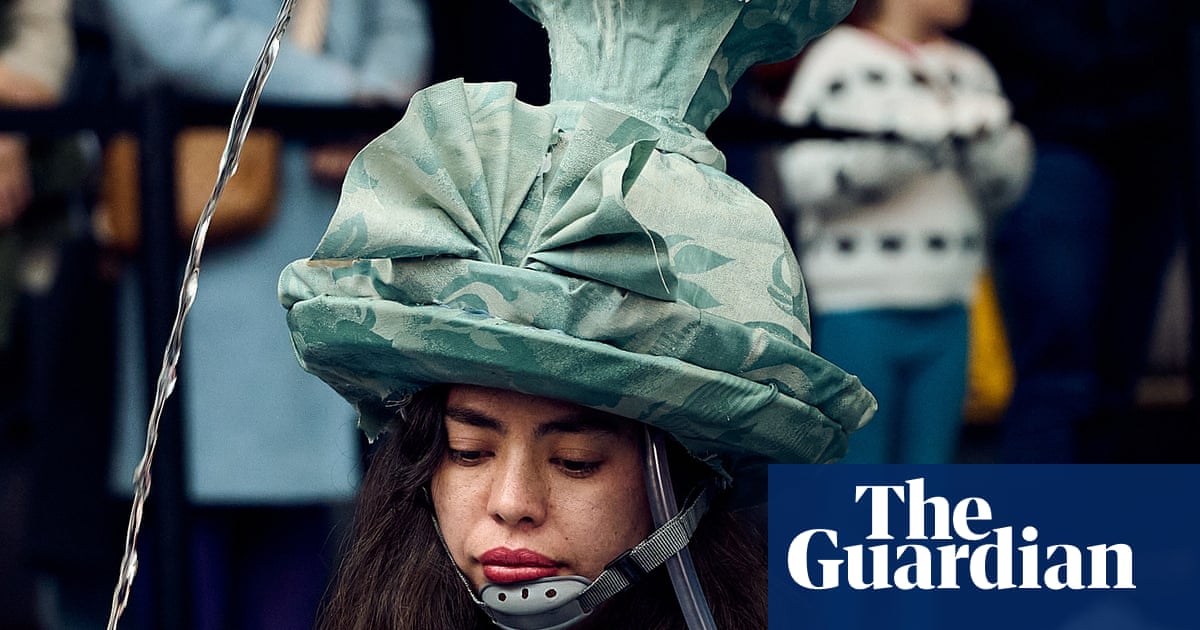Iam someone who finds it extraordinarily difficult to sit still or be quiet. On one family road trip, my mother challenged me not to speak for 20 minutes, with a prize of $100 for my efforts. I lasted approximately 30 seconds. My ADHD diagnosis at 32 was the natural progression of my life.
TheSpace-out competition, held in Melbourne on Monday, was the ultimate test of whether I could fight my own nature and embrace nothingness. Created by South Korean artist Woopsyang as a response to her own experience of burnout, the competition has been running for more than a decade around the world with a simple proposition: a mini-city of competitors, all dressed as their jobs, sit in a public space doing absolutely nothing for 90 minutes.
Laughing, chatting, using technology or falling asleep results in disqualification – “lifeguards” patrol around monitoring everyone’s activity, or lack thereof. A large yellow card is a warning, and a red one is a disqualification. Participants can raise smaller coloured cards to ask for warmth, water, a massage or to exit the competition. Every 15 minutes, “doctors” measure participants’ heart rates. The watching crowds vote on their favourite competitor, which, when combined with the heart rate measurement, determines the overall winner.
Sign up for the fun stuff with our rundown of must-reads, pop culture and tips for the weekend, every Saturday morning
Because I am a self-respecting journalist, my outfit is a fedora adorned with a card reading PRESS. My competitors include an actual dog, an elderly man (who turns out to be the oldest-ever participant in the competition), a woman sitting in a tub with a functioning fountain on her head, a Teletubby, a chef (with a Ratatouille toy on their head) and a bunch of young kids.
We’re all invited to write our reasons for participating on a board the public can read and vote on. The answers range from earnest to silly. “To calm my nervous system,” one reads. “I’m extremely unemployed,” reads another.
Woopsyang comes to the stage, wearing the traditional male Korean ceremonial garb, including the wide-brimmedgat, and makes a speech via an unfurling ribbon. “Sometimes doing nothing can be the most powerful and valuable act,” it reads. We participate in stretching and aerobic exercises before sitting on our mats. The timer begins.
Out of the corner of my eye, I can see my partner taking photos of me, but I try to ignore him and focus on a fixed point in front of me. I try not to move. I’m desperate to get up, to shake my limbs, but I keep sitting. My mind is not blank, but I try to engage the meditation techniques my Buddhist mother taught me.
I can hear comedian commentators Harry Jun and Oliver Coleman telling the crowd that the young boys left the competition 20 minutes in, that warnings have already begun to be handed out, that someone’s ice-cream has melted. I want to look around, but I can’t. I can hear the public around me. I feel like an animal in a zoo.
The only marker of time is when a doctor approaches to measure my heart rate; I’m surprised to find the 15-minute increments feel shorter every time. Each time a doctor comes over, I know I’m closer to my goal – and my heart rate is steadily decreasing. I’m in the zone, baby.
I raise my blue card once to ask for water, and my yellow one once for warmth, which turns out to be a small sock with a heat bag in it (not useful!). But after a while, doing nothing becomes quite pleasant. My mind is still not quite blank but I enter a liminal state. The sound of the crowd has become white noise. When the final whistle is blown, I’m shocked that it has been an hour and a half. I could happily have sat and done nothing for much longer.
Alas, I do not place – the fountain lady, who admits that the trickling water in her costume was designed to make her fellow contestants need to pee, is declared the winner. I find out later via Instagram that she’s been working on the costume for months, unlike mine, which I made in about two minutes. She deserves the win.
But winning is kind of beside the point of the Space-out competition. I proudly tell my family that I managed to sit still and be quiet for 90 minutes straight in public. I won’t get $100 from my mum for this but I finally won the bet, after all.
